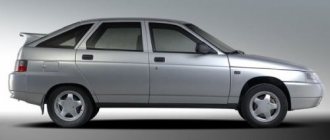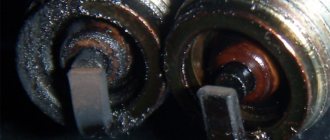The small car "Oka", developed in 1988 at VAZ, was supposed to become one of the most popular cars before the collapse of the USSR, but until 1994 it was produced in small batches, and since 1995, production was completely transferred to KamAZ and SeAZ. The peak of production began in 1998, when Oka began not only to be sold domestically, but also actively exported - due to the fall in the ruble exchange rate, its price in foreign currency turned out to be ridiculous. But the outdated design of the body and power unit did not allow the car to successfully compete with higher quality and reliable foreign analogues in the early 2000s, so its production was discontinued in 2008.
Oka 0.7
From the very beginning, a VAZ-1111 micro-displacement carburetor engine with a volume of 649 cm3 was developed for the Oka. This two-cylinder engine was capable of developing a power of 30 hp. and reach a torque of 45 Nm. The engine was paired with a 4-speed manual transmission.
Oka fuel consumption rate is 0.7 l per 100 km
- Maxim, Ufa. I have an Oka VAZ-1111, manufactured in 1994. Despite its unpresentable appearance, the car is not bad and suits me 100%. For its weight, the engine power is quite enough. By the way, consumption in the city is quite normal - 5-7 liters, but on the highway, if you drive too hard, sometimes it can reach 10 liters.
- Timur, Ryazan. I took it literally for a couple of years - it was stupid to learn how to drive. Even if I knock or break it, I don’t mind at all. However, everything turned out to be not as sad as I thought. It drives and that’s the main thing, although it doesn’t even smell like comfort. The average consumption is 6 liters – which is a lot for the tiny volume under the hood.
- Georgy, Tambov. Oka is my first car. I got it from my dad, and before that it had been sitting in the garage for five years and was rusting. Of the advantages, I will only note its unpretentiousness and the fact that it is the same Lada, only neutered and trimmed down. Gasoline consumption with a normally adjusted carburetor is 6 liters in the city, more on the highway, because the gearbox is 4-speed and at more than 90 km/h it eats gasoline like a cow.
- Irina, Rostov. When I decided to learn to drive a car, I went to a driving school, after which my father finally entrusted me with his car - a 1992 Oka. At that time, for me it was just something - but now I understand that the car was an outright log and not worth a good word. It broke down constantly, the consumption in the city was no less than 6 liters, I now have this consumption on my Hyundai with an engine 2.5 times more and 3 times more powerful.
- Sergey, Moscow. At one time, I rode a 1993 Oka for about a year and a half. This was in 2008 - I needed wheels, but there was no money, so I took an Oka, which at that time cost me about $300 - just ridiculous money. I’ll tell you that in fact everything is not as bad as it seems - if we put aside emotions, demands for comfort and all that, then this car fulfills its main purpose of transporting you from point A to point B 100%, and nothing more. need to. Consumption in the city is on average 6.5 liters, and it is generally undemanding when it comes to the quality of gasoline.
Other cars: Lada Priora fuel consumption
General description of the carburetor, design features
Fuel consumption Hyundai Santa Fe
What kind of carburetor is on OKE? This device is produced at the Dimitrovgrad Automotive Unit Plant, it is called the DAAZ 1111 1107010 carburetor.
The OKI carburetor, after modification, has some features that distinguish it from analogues installed on other cars, for example, the float chamber is located across the carburetor body. This approach allows you to obtain an enriched fuel mixture during acceleration or braking.
In addition, carburetors in this series have a simplified design due to the fact that there are practically no electronic components.
The design of this unit includes the following assembly units and components:
- valve mechanism;
- engine starting device;
- fittings;
- adjustment lever;
- throttle valves;
- chamber with a float mechanism.
All of the listed components are assembled in one housing. To protect them from street dirt and atmospheric influences, a protective cover is installed.
In an OKA car, the carburetor can be divided into three parts - upper, middle and lower.
Carburetor DAAZ 1111 1107010 top view of the carburetor: 1 - accelerator pump cover, 2 - solenoid valve on the fuel jet of the idle system, 3 - air damper of the starting device, 4 - cover of the diaphragm mechanism of the starting device, 5 - lever of the starting device, 6 - holder sheath of the air damper control cable, 7 - crankcase gas supply fitting. 8 — fuel supply fitting.
The first includes the cover, air filter mounting studs and fuel supply fittings. The second part includes the carburetor itself, complete with diffusers and a float chamber, in which the proper fuel level must be maintained. The third is equipped with throttle valves and drive rods.
The carburetor that is installed on an OKA car is designed to solve the same problems as similar devices that are used on other models of passenger cars. And the operating scheme of such devices is approximately the same, that is, liquid fuel enters the float chamber and is supplied to the chamber where it is saturated with air.
Fuel droplets are crushed using atomizers installed there and this allows air to easily penetrate into the fuel. After enrichment, the mixture, passing through diffusers, rushes into the combustion chamber.
Oka 0.8
In 1995, on the basis of the fairly successful VAZ-21083 engine, a stripped-down two-cylinder version of the VAZ-1113 was developed, which was equipped with the Oka car. This 750 cm3 carburetor engine developed a power of 35 hp, and the engine torque was 52 Nm. The engine was paired with a 4-speed manual transmission.
Real reviews about Oka fuel consumption 0.8 l per 100 km
- Andrey, Vladimir. I have a 2002 Oka with a 0.75 liter engine. For the money, the car is not bad, but when compared with others, it loses to everyone. There are simply zero amenities in the cabin, it constantly breaks down, although spare parts are very cheap and cost pennies. Over the course of a couple of years, I replaced four bumpers – repairing them is not an option at all, only replacing them. Consumption in the city is 7.5 liters - I’m surprised, I thought it would be much less.
- Evgeniy, Kursk. The car was made in 1997, naturally I took it second-hand, with a mileage of more than 60 thousand km. At the same time, the car stood in the garage for almost 6 years - naturally, I had to change all the gaskets, rubber bands, etc., and fill in technical fluids. The problem was with the wiring - it kept melting. Nevertheless, it is quite unpretentious and easy to maintain, but the consumption is high, as for a 0.75 liter engine - approximately 7-7.5 liters in the city, 6.5 liters on the highway.
- Kirill, Ufa. Considering that the engine in my Oka is half of the figure-eight engine that is installed on the VAZ-21083, I can’t understand why it consumes so much gasoline. The actual consumption is within 7 liters, my friend has a VAZ-21083, so that one consumes 8-9 maximum.
- Dmitry, St. Petersburg. The main advantage of Oka is its compact dimensions. It looks like there's no room, but there's actually plenty of space, especially for the driver and front passenger. Of course not at the back, but that's not a problem. Plus you can park wherever you want - for St. Petersburg this issue is acute. Consumption in the city is about 7-8 liters, but it pulls surprisingly well, you can even overtake.
- Vladimir, Orel. I owned the VAZ-1113 Oka for almost 4 years. At the time of purchase, the mileage was 45,000 km, the car was owned by a retired grandfather, who drove it once every five years. The advantage of the car is its size and the 0.75 liter engine, which is high-torque for its volume. Everything else needs to be improved - the steering, suspension and so on have been redone. Well, the weak metal of the body began to rot very quickly, even though I cooked it.
Other cars: VAZ 21213 fuel consumption reviews
The main reasons for increased fuel consumption.
There is no driver who would never think about the fuel consumption of his car. Believe me, even owners of expensive supercars think about fuel consumption. The fact is that most often increased fuel consumption can be a sign of a car malfunction. Unfortunately, finding faults that may have caused increased fuel consumption can be lengthy and difficult.
1GAI.RU invites you to familiarize yourself with the most common reasons why a car begins to consume too much fuel.
We all know that fuel from the tank flows through a gas line into the combustion chamber of the engine. The amount of fuel that enters the power unit depends on many factors. Therefore, it is quite natural that a car cannot constantly consume the same amount of fuel. It is quite normal for a vehicle to consume either more or less gasoline or diesel fuel, depending on its operating conditions. For example, first of all, consumption depends on how loaded the car is (empty or with a full interior of passengers and luggage).
Also important is the distance over which the car travels. In addition, of course, do not forget about the time of year the machine is used.
It's no secret that in winter a car consumes much more than in summer. Moreover, all external factors and driving style affect not only gasoline engines, but also diesel vehicles.
In most cases, increased fuel consumption is not associated with any malfunctions in the car. Most often, each driver can influence fuel consumption by changing his driving style. In order to reduce fuel consumption, it is necessary to inspect the wheels and some other parts of the car, which, although in good condition, may nevertheless be the main cause of excessive fuel consumption.
But it is not uncommon for increased fuel consumption to be associated with possible defects in vehicle components. In this case, it will not be possible to solve the problem quickly. After all, to do this you must first identify the fault. Unfortunately, it is very difficult to find a defect that caused increased consumption of gasoline or diesel fuel.
Firstly, the reasons for excessive fuel consumption can be both external and internal factors (car breakdowns).
Secondly, everything in a car is interconnected and the cause of increased fuel consumption may be defects in several components.
Oka 1.0
The latest versions of the Oka, produced at SeAZ since 2006, received a Chinese three-cylinder small engine with a volume of 1000 cm3, which was also installed on the Daihatsu Charade G10. This engine was significantly superior in its characteristics to VAZ units - its power reached 53 hp and torque - 77 Nm. In addition, a more modern 5-speed manual transmission was offered for this engine.
Real fuel consumption Oka 1.0 l
- Yuri, Kaluga. I bought Oka for one simple reason - money, or rather, the lack of it. Actually, I have a GAZ-3110, but this car is too power hungry and not suitable for every day. But the Oka, especially with an imported engine, has low consumption, about 6.5 liters in the city and 5 liters on the highway - the Volga has two to two and a half times more. That’s why I ride the Oka all over the city, and if I go somewhere with my family, it’s on the Volga.
- Alexander, Kirov. I've had Oka for over 10 years. I have driven more than 200 thousand km. During this time, I made a capital overhaul of the engine - at 150 thousand km it stupidly caught a wedge, I had to completely overhaul it. By the way, after the capitalization the engine began to work perfectly simply - consumption dropped to 6 liters on average, sometimes even less, it pulls amazingly with such a volume. Plus I did the steering properly and slightly modified the suspension.
- Vasily, Samara. My Oka is a car for every day. I don’t care that the car is not prestigious - the main thing is that it drives and at the same time consumes a minimum of gasoline. I pump out 20-30 liters per day, covering 350-400 km. And it’s very cheap and easy to repair; it can be done by any auto mechanic whose hands grow where they need to.
- Dmitry, Simferopol. Through a friend, purely by chance, I became the owner of an Oka with a Chinese 1.0 liter engine. I bought it solely because of the price - they offered it to me for 400 bucks, a “penny” costs an order of magnitude more. The car is nothing at all - the interior completely sucks, there is no space at all, the engine has a thousand cubic meters, but in the city it consumes at least 7 liters of gasoline.
- Alexey, Moscow. My father-in-law gave me the car so I could learn to drive. He bought himself a Priora, and I didn’t have much money, so for me any option was normal. Over the course of 2 years, I certainly killed her in the trash, but I didn’t feel sorry for her. What was pleasing was the consumption of 6 liters, and sometimes even less.
Other cars: VAZ 2121 fuel consumption reviews
A little history of the VAZ-1111
The first such car rolled off the assembly line of the Volzhsky Automobile Plant in 1987. It was the first minicar of its kind to appear in the Land of the Soviets. VAZ could not produce such a “baby” on its own due to the fact that all the equipment was specialized for the production of Lada cars. That is why two more plants were brought in to help: KamAZ and SeAZ.
Due to their low cost and fairly low consumption, these small cars remained in demand even after the collapse of the Union. With the sharp collapse of the ruble at the turn of the century, the price of a car fell to a minimum, and therefore sales increased sharply, but this did not last long. By 2007, the car was hopelessly outdated.
For an initial acquaintance with the car, you can watch a short video.











